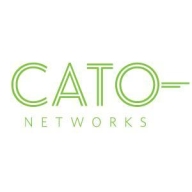

Find out in this report how the two Intrusion Detection and Prevention Software (IDPS) solutions compare in terms of features, pricing, service and support, easy of deployment, and ROI.
The solution can save costs by improving incident resolution times and reducing security incident costs.
Their knowledge portal and Cato Academy portal are excellent resources.
Our customer service experience is excellent
They provide very good technical support.
Mission-critical offering a dedicated team, proactive monitoring, and fast resolution.
From the responsiveness perspective, Splunk is very responsive with SLA-bound support for premium tiers.
I would rate their technical support as 8.5 out of 10.
As an MSSP, we find it scalable for end users across EPP platforms, network, and cloud sides.
Splunk User Behavior Analytics is highly scalable, designed for enterprise scalability, allowing expansion of data ingestion, indexing, and search capabilities as log volumes grow.
I would rate the stability of the solution as ten on a scale of one to ten.
We have not seen many issues with Cato SASE Cloud Platform recently.
With built-in redundancy across zones and regions, 99.9% uptime is achievable.
Splunk User Behavior Analytics is a one hundred percent stable solution.
Splunk User Behavior Analytics is highly stable and reliable, even in large-scale enterprise environments with high log injection rates.
The platform lacks strong security features on the edge.
The kind of integrations they offer today, in the future, I would think they would add more and more feature sets, especially around where they remove the dependency of having specialist solutions on a typical monitoring side.
Global reach allows deployment of apps and services closer to users worldwide, but data sovereignty concerns exist and region selection must align with compliance requirements.
I encountered several issues while trying to create solutions for this advanced version, which seem unrelated to query or data issues.
High data ingestion costs can be an issue, especially for large enterprises, as Splunk charges based on the amount of data processed.
The features are available for much less than Palo Alto.
The pricing is flexible due to our special partnership with Cato Networks.
Reserved instances with one or three-year commitments offer lower rates, providing up to 70% savings.
Compared to all other products in the market, it is the most expensive one in all aspects including professional service and licenses, even the cloud version.
Comparing with the competitors, it's a bit expensive.
It is scalable for end users across network and cloud sides and saves operational costs.
They offer a very lightweight and powerful console where it has everything needed to manage as a service.
I also utilize it for anomaly detection and behavior analysis, particularly using Splunk's machine learning environment.
The dashboards themselves are nice, very good, and very helpful, but the accuracy of the data or the information that will be presented on the dashboard is something that needs to be questioned.
Features like alerts and auto report generation are valuable.
| Product | Market Share (%) |
|---|---|
| Cato SASE Cloud Platform | 2.7% |
| Splunk User Behavior Analytics | 1.9% |
| Other | 95.4% |


| Company Size | Count |
|---|---|
| Small Business | 14 |
| Midsize Enterprise | 7 |
| Large Enterprise | 10 |
| Company Size | Count |
|---|---|
| Small Business | 7 |
| Midsize Enterprise | 5 |
| Large Enterprise | 12 |
Cato Networks is a leading SASE (Secure Access Service Edge) platform, combining SD-WAN and network security to obtain a cloud-native service. Cato Networks optimizes and secures application access for users and identities. The platform delivers a next-generation secure networking architecture that minimizes legacy IT infrastructures’ complexity, costs, and risks. The goal of Cato Suite is to connect any user to any application securely and optimally.
Cato Suite runs on a private global network of more than 65 PoPs (points of presence) connected via SLA-backed network providers. The service can connect branches, data centers, users, and clouds. Cato can be deployed in stages to augment legacy network services.
Cato Suite delivers end-to-end route optimization for WAN and cloud traffic. The architecture is self-healing, enabling a high service uptime.
Cato Features
Cato Cloud has a global backbone to deliver a reliable, global network. Here are some key SD-WAN features of Cato Cloud.
What challenges does Cato Network solve?
MPLS (multi-protocol label switching) networks are usually expensive and limited in their capacity. Cato simplifies migrating to a faster, higher-capacity internet and SASE cloud. Cato SD-WAN appliances enable customers to improve usable capacity and resiliency.
Customers who suffer from the challenge of high latency and network inconsistency can use Cato to deliver a consistent connection and user experience to access on-premises and cloud applications.
Cato’s complete network security stack connects all branch locations to the Cato cloud, therefore protecting all traffic, both internet-bound and WAN, with enterprise-grade, cloud-based security services. This capability avoids having to backhaul internet traffic to a data center or hub or having to implement stand-alone cloud security solutions.
Organizations using Cato notice an acceleration of cloud traffic. Cato achieves this by routing all traffic from the edges to the PoP closest to the data center. Because of the close distance between the two, the latency is near zero.
Reviews from Real Users
An IT manager/project coordinator at a healthcare company says that “[Cato is] a cloud-based solution that integrates well with everything. They are the classic SaaS solution.”
Yeong-Gi L., a network engineer at Snetsystems, notes that “The solution is very stable. The scalability is quite good. Technical support was always helpful and responsive. The integration capabilities are not a problem at all.”
"The most valuable feature is that it also works as a next-gen firewall because it has security features," says Lorenzo S., senior solutions consultant Lead at MDI.
Splunk User Behavior Analytics is a behavior-based threat detection is based on machine learning methodologies that require no signatures or human analysis, enabling multi-entity behavior profiling and peer group analytics for users, devices, service accounts and applications. It detects insider threats and external attacks using out-of-the-box purpose-built that helps organizations find known, unknown and hidden threats, but extensible unsupervised machine learning (ML) algorithms, provides context around the threat via ML driven anomaly correlation and visual mapping of stitched anomalies over various phases of the attack lifecycle (Kill-Chain View). It uses a data science driven approach that produces actionable results with risk ratings and supporting evidence that increases SOC efficiency and supports bi-directional integration with Splunk Enterprise for data ingestion and correlation and with Splunk Enterprise Security for incident scoping, workflow management and automated response. The result is automated, accurate threat and anomaly detection.
We monitor all Intrusion Detection and Prevention Software (IDPS) reviews to prevent fraudulent reviews and keep review quality high. We do not post reviews by company employees or direct competitors. We validate each review for authenticity via cross-reference with LinkedIn, and personal follow-up with the reviewer when necessary.